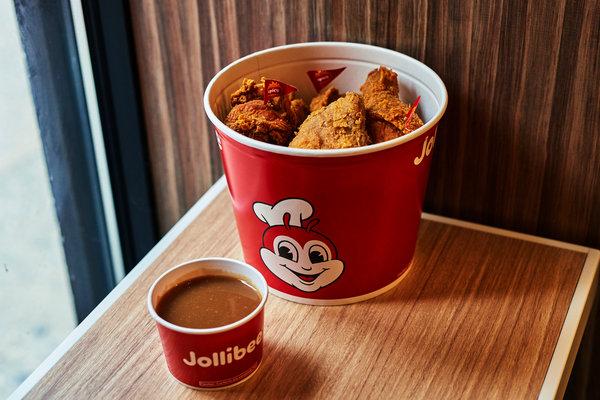The first McDonald’s opened in the Philippines in 1981, ready to conquer. Instead, it met its match: Jollibee, originally a small suburban ice cream franchise that started selling burgers in the late 1970s. By 1984, it had clobbered its American rival, cornering the fast-food market on its home turf and still dominating it to this day.
Jollibee’s founder, Tony Tan Caktiong, had studied the competition. So by the time Ronald McDonald set foot in Manila, with his billowy yellow jumpsuit and shock of red hair, the clown had been pre-empted by a tall, red-and-yellow-striped bee in a dapper little chef’s hat, bow tie and tails.
A glossy statue of the plump-cheeked bee greets diners at the chain’s latest American outpost — its 37th, and first in Manhattan — which opened in October near the Port Authority Bus Terminal. The night before, people waited in line in the rain to be the first diners, some wearing antennas and wings.
What inspires such loyalty? Long ago, fried chicken eclipsed burgers as Jollibee’s most sought-after offering. The pleasures of Chickenjoy, as it’s called, are immediate: The sheath of skin is as craggy as a thunderhead, crannies and crunch multiplying.

The marquee item at Jollibee is Chickenjoy: fried chicken with a sheath of skin as craggy as a thunderhead.CreditAn Rong Xu for The New York Times
Underneath, the flesh is juicy, with its own generous measure of salt and secret seasonings, if not quite as potent as the skin’s. Online recipe hacks typically deploy garlic and Chinese five-spice to approximate the skin’s fervor. Spicy Chickenjoy is even better, both marinade and breading infiltrated with some form of chile — flagrant but not searing, just enough to jack up the pulse.
Every order of Chickenjoy comes with gravy, whether you order a side of mashed potatoes or not. This makes sense given the elevated place of condiments in Filipino cuisine, although my mother, who grew up in Cotabato City in the southern Philippines, prefers to dunk a drumstick in ketchup or the Filipino enhancement of it, bolstered with banana — sadly not stocked here.
Mr. Caktiong, the son of poor Chinese immigrants, is now a billionaire, and 150 Jollibees are set to open in the United States within five years. Like the Manhattan store, many will be outside immigrant enclaves, waylaying diners with limited knowledge of Filipino food.
These newcomers may be slightly baffled by the Jolly Spaghetti. It looks Italian, with its blanket of ragù, but under the ground beef are nubs of hot dog and ham, and the presiding note is sweet. It’s fairly mellow, as Filipino spaghetti goes, with more of an earthy counterpoint than other versions of the dish I’ve tried. (That includes an anemic McSpaghetti, the McDonald’s take, in Manila years ago.) But it may not bridge the cultural divide.
This is a missed opportunity, because Jollibee has a great Filipino noodle dish on its roster, currently unavailable in Manhattan: palabok, rice noodles in a rich, briny sauce, traditionally made with shrimp stock and crushed shrimp shells and heads. Jollibee’s closely guarded recipe may differ, but the finished dish — as served at its branch in Woodside, Queens, which opened in 2009 — arrives appropriately attired, heaped with ground pork, a dusting of crushed chicharron, hard-boiled eggs and a few scattered shrimp.
So the shrimp are as pale as fingernails. What do we ask of a quick-serve restaurant, beyond a dish that we don’t have time to cook at home, made with some sense of honor for what the dish could be, despite a limited budget for ingredients? In Queens, Jollibee’s palabok — labeled Fiesta Noodles on the menu — costs $6.19, drink included. It is delicious.
Only in Queens, too, on this strip known as Little Manila for its population of Filipino immigrants, will you find Jollibee’s halo-halo, feathery shaved ice under orbs of ube (purple yam) and jackfruit ice cream and a tilting block of leche flan. At the bottom, waiting to be dredged up, are beans boiled in sugar and wobbly nata de coco (coconut water fermented into jelly).
At the Manhattan storefront, this is edited down into a sundae of vanilla soft-serve topped with nata de coco, chickpeas and a daub of ube halaya (half-custard, half-jam) — the best parts, too few, and gone too quickly.
Fortunately, both locations sell peach-mango pie, which may be as close as you can get to your childhood memory of McDonald’s apple pie, back when it was still deep-fried. Jollibee’s has a gilded sleeve of bubbled crust and a filling no sweeter than need be; take one home, crisp it in the oven the next day, and it still makes life complete.
At the end of a long day, Jollibee is a startlingly uncynical place to be. The Queens outpost, at 10 years old, still looks new, with its shiny communal tables under red lampshades; a manager leaped to open the door for me when I left. And in Manhattan — even though I knew it was a script, that it couldn’t possibly be personal — when the cashier said, “Have a jolly night,” I did.
609 Eighth Avenue (40th Street), Midtown West; 212-994-2711; jollibeeusa.com; and 62-29 Roosevelt Avenue (63rd Street), Woodside, Queens; 718-426-4445; jollibeeusa.com
Follow NYT Food on Twitter and NYT Cooking on Instagram, Facebook and Pinterest. Get regular updates from NYT Cooking, with recipe suggestions, cooking tips and shopping advice.




